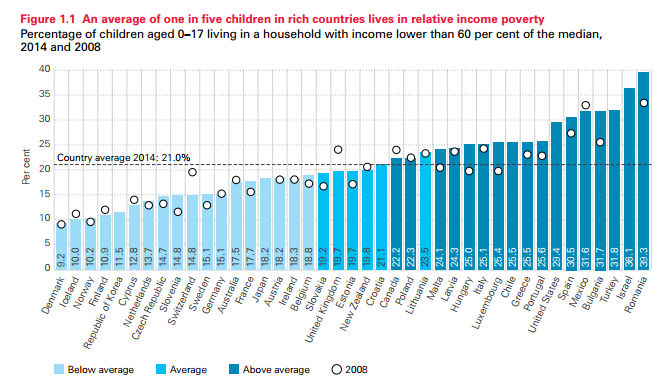These rich countries have high levels of child poverty

The United States performs poorly in the child equality rankings.
Image: REUTERS/Shannon Stapleton
Stay up to date:
Economic Progress
One in five children in rich countries lives in relative poverty. And one in eight risks going hungry or not getting the right food.
A new Unicef report ranked 41 of the world’s wealthiest countries on how well prepared they are to meet the UN’s Sustainable Development Goals most relevant to child well-being.
It warned that in many of the countries studied higher incomes have failed to improve the lives of all children. This was notably the case in the United States and United Kingdom, where one in five children faces food insecurity. In comparatively poorer Mexico and Turkey this figure rises to one in three.
Unicef defines relative child poverty as living in a household whose disposable income, taking into account the size of the family, is less than 50% of the median income for the country in which they live.

There are wide variations in child poverty levels between countries. In Denmark, Norway and Iceland, one in 10 children lives in poverty, compared to one in three in Israel and Romania.
Again, the US performs badly against this indicator, as does Spain. In fact, 17 of the 41 countries have above average levels (21%) of children living in poverty.

The best and worst performers on child well-being
Overall, the countries that performed best across the indicators on children’s well-being were the Nordic nations, Germany and Switzerland. At the bottom of the league table were Chile, Bulgaria, Romania, Mexico and the US.
However, the report points out that there is room for improvement in all countries, with each ranking in the middle or bottom third for at least two of the goals. Across Europe one child in three is deprived in at least two ways.

There has been significant progress in some areas with falls in neonatal mortality, adolescent suicides, teenage births and drinking.
However, on other indicators – income inequality, adolescent self-reported mental health and obesity – rich countries are actually on a downward trajectory.
The United Nations World Food Programme defines food security as having reliable and consistent access at all times to sufficient, safe, nutritious food to maintain a healthy and active life.
In two thirds of the countries, children from the poorest households are now worse off than they were in 2008. Obesity rates among 11-15 year olds are climbing, and so is the number of adolescents reporting two or more mental health problems a week.
Accept our marketing cookies to access this content.
These cookies are currently disabled in your browser.
Don't miss any update on this topic
Create a free account and access your personalized content collection with our latest publications and analyses.
License and Republishing
World Economic Forum articles may be republished in accordance with the Creative Commons Attribution-NonCommercial-NoDerivatives 4.0 International Public License, and in accordance with our Terms of Use.
The views expressed in this article are those of the author alone and not the World Economic Forum.
Related topics:
Forum Stories newsletter
Bringing you weekly curated insights and analysis on the global issues that matter.
More on Economic GrowthSee all
Jill Klindt and Mandi McReynolds
May 30, 2025
Sergio Navajas and Jimena Sotelo
May 29, 2025
John Letzing
May 29, 2025
Naala Oleynikova
May 28, 2025





